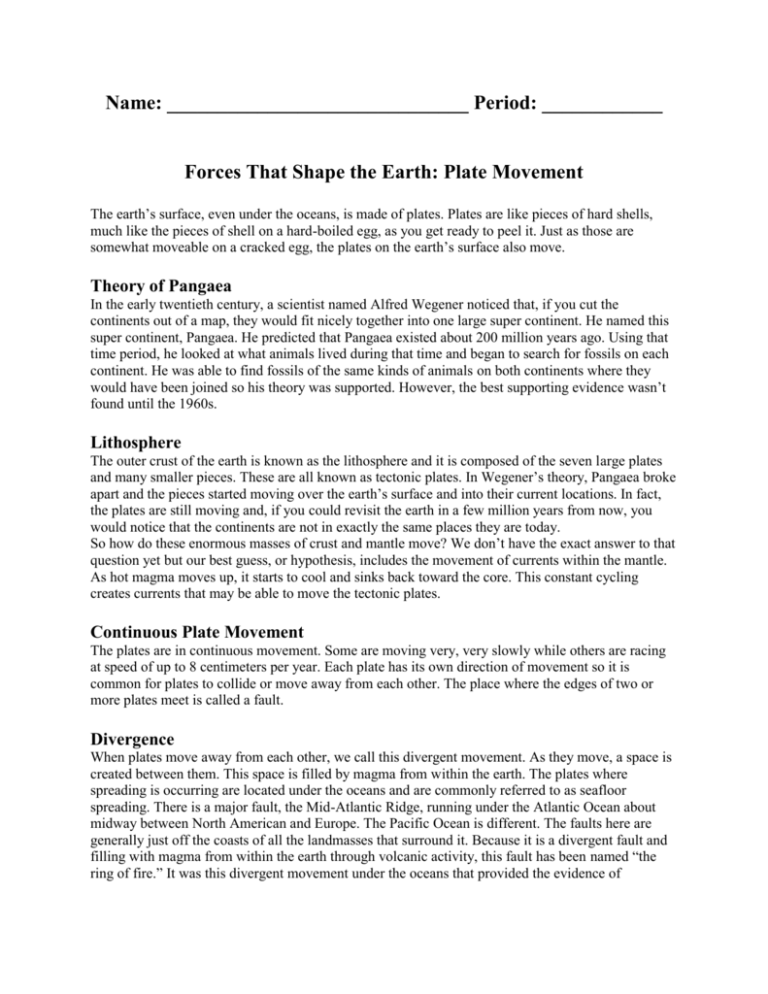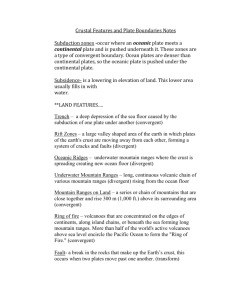Period: ______ Forces That Shape the Earth: Plate Movement
advertisement

Name: ______________________________ Period: ____________ Forces That Shape the Earth: Plate Movement The earth’s surface, even under the oceans, is made of plates. Plates are like pieces of hard shells, much like the pieces of shell on a hard-boiled egg, as you get ready to peel it. Just as those are somewhat moveable on a cracked egg, the plates on the earth’s surface also move. Theory of Pangaea In the early twentieth century, a scientist named Alfred Wegener noticed that, if you cut the continents out of a map, they would fit nicely together into one large super continent. He named this super continent, Pangaea. He predicted that Pangaea existed about 200 million years ago. Using that time period, he looked at what animals lived during that time and began to search for fossils on each continent. He was able to find fossils of the same kinds of animals on both continents where they would have been joined so his theory was supported. However, the best supporting evidence wasn’t found until the 1960s. Lithosphere The outer crust of the earth is known as the lithosphere and it is composed of the seven large plates and many smaller pieces. These are all known as tectonic plates. In Wegener’s theory, Pangaea broke apart and the pieces started moving over the earth’s surface and into their current locations. In fact, the plates are still moving and, if you could revisit the earth in a few million years from now, you would notice that the continents are not in exactly the same places they are today. So how do these enormous masses of crust and mantle move? We don’t have the exact answer to that question yet but our best guess, or hypothesis, includes the movement of currents within the mantle. As hot magma moves up, it starts to cool and sinks back toward the core. This constant cycling creates currents that may be able to move the tectonic plates. Continuous Plate Movement The plates are in continuous movement. Some are moving very, very slowly while others are racing at speed of up to 8 centimeters per year. Each plate has its own direction of movement so it is common for plates to collide or move away from each other. The place where the edges of two or more plates meet is called a fault. Divergence When plates move away from each other, we call this divergent movement. As they move, a space is created between them. This space is filled by magma from within the earth. The plates where spreading is occurring are located under the oceans and are commonly referred to as seafloor spreading. There is a major fault, the Mid-Atlantic Ridge, running under the Atlantic Ocean about midway between North American and Europe. The Pacific Ocean is different. The faults here are generally just off the coasts of all the landmasses that surround it. Because it is a divergent fault and filling with magma from within the earth through volcanic activity, this fault has been named “the ring of fire.” It was this divergent movement under the oceans that provided the evidence of continuous plate movement. In the 1960s, scientists observed bands of rocks on the ocean floor that were created during specific times in earth’s history and could not have been created at other times. Convergence Although some plates diverge, or move away, from each other, many more converge, or move toward, each other. When two plates converge, either they both crumble where they collide or one plate runs under the other and is forced downward toward the earth’s core. When one plate slides under the other, this is called subduction. As the sub-ducted plate moves downward, it melts down in the hot magma. The plate that rides over the other responds differently according to what type of plates are colliding. When two continental plates converge, such as where the Indian Plate is colliding with the Eurasian Plate, they crumple and form mountains such as the Himalayan Mountains, the highest mountains in the world. When two ocean plates converge, one is usually sub-ducted under the other. Where one plate plunges downward, a trench is created. A line of volcanoes commonly forms parallel to this trench. Over years of eruptions, these volcanoes may eventually grow large enough to rise above the ocean surface and create a chain of islands. The third type of convergence occurs when an ocean plate meets a continental plate. The continental plate will ride over the oceanic plate and, just as with two oceanic plates, a trench will form just off the coast of the continental plate. Transformation Some plates do not meet head-on but slide past each other instead. When two plates, moving in opposite directions meet, they often grate together along the fault line between them. The most famous transformation fault is the San Andreas Fault in California. Most of the State of California is on the continental plate but a small part along the southern coast is actually on the oceanic plate. The continental plate, including such cities as San Francisco, is moving south while the oceanic plate, including Los Angeles and San Diego, is moving north. If we could revisit the earth again in millions of years, San Francisco may actually be located south of Los Angeles. Name: ______________________________ Period: ____________ Questions for Review 1. Identify the correct term for the following types of plate movements: a. Two continental plates move toward each other _________________ b. Two ocean plates move away from each other _________________ c. Two plates move past each other in opposite directions _________________ 2. There is a string of islands just off the coast of Alaska known as the Aleutian Islands. We learned that a string of volcanoes might arise alongside an ocean trench and produce islands. What type of plate movement is capable of producing a chain of islands and what two types of plates are involved? ___________________________________________________________________________ 3. What did Wegener do that lead him to think that all of our continents were once part of a single, large continent? _________________________________________________________________________________ _____________________________________________________________________ 4. Wegener gave a name to his super continent. He called it ___________________________. 5. Which of the three types of plate movement provided some evidence and supported Wegener’s theory? __________________________________________________________ 6. When plates move, they create new geologic features. Which type of plate movement is responsible for each of these? The Mid Atlantic Ridge ____ the San Andreas Fault ____ Himalayan Mountains ____ A. Convergence: continent to continent B. Convergence: continent to oceanic C. Transformational D. Divergence 7. When two ocean plates move apart, what do you think happens? _________________________________________________________________________________ _________________________________________________________________________________






